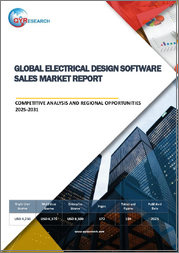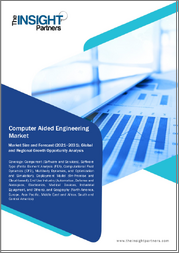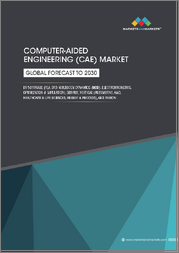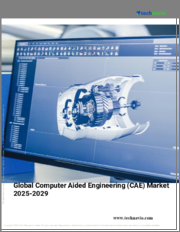
|
시장보고서
상품코드
1806319
컴퓨터 지원 엔지니어링 시장 : 제공 서비스, 기술, 전개, 용도, 최종 이용 산업, 기업 규모별 - 세계 예측(2025-2030년)Computer Aided Engineering Market by Offering, Technology, Deployment, Application, End-Use Industry, Enterprise Size - Global Forecast 2025-2030 |
||||||
컴퓨터 지원 엔지니어링 시장은 2024년에는 124억 8,000만 달러로 평가되었으며, 2025년에는 136억 3,000만 달러, CAGR 9.57%로 성장하여 2030년에는 216억 달러에 달할 것으로 예측됩니다.
| 주요 시장 통계 | |
|---|---|
| 기준 연도 2024년 | 124억 8,000만 달러 |
| 추정 연도 2025년 | 136억 3,000만 달러 |
| 예측 연도 2030년 | 216억 달러 |
| CAGR(%) | 9.57% |
업무 효율을 높이고 업계에서 전략적 우위를 점할 수 있는 첨단 컴퓨터 지원 엔지니어링의 실무별 혁신 가속화
컴퓨터 지원 엔지니어링은 물리적 프로토타입이 생산에 들어가기 전에 시뮬레이션, 분석, 설계 최적화를 가능하게 하여 제품 혁신의 핵심이 되고 있습니다. 가상 모델과 실제 데이터를 통합함으로써, 어떤 산업이든 상관없이 팀은 잠재적인 문제를 식별하고, 시장 출시 시간을 단축하고, 전체 개발 비용을 절감할 수 있습니다. 지속가능성 목표에서 규제 준수에 이르기까지 점점 더 복잡해지는 요구사항에 대응하기 위해 기업이 CAE 솔루션을 효과적으로 활용하는 능력은 경쟁 우위에서 비즈니스 필수 요소로 변화하고 있습니다.
컴퓨터 지원 엔지니어링 전략과 경쟁 역학을 재구성하고 있으며, 중요한 기술 및 시장 파괴에 대한 인식이 재편되고 있음
새로운 기술의 융합과 시장 수요의 변화로 인해 컴퓨터 지원 엔지니어링의 정세는 급변하고 있습니다. 머신러닝과 인공지능을 통해 복잡한 시뮬레이션 작업이 자동화되기 시작했고, 실시간으로 적응하는 예측 모델링이 가능해졌습니다. AI를 활용한 해석과 기존 유한요소법 및 유체역학 툴을 결합하여 정확도를 높이고 수동 개입의 필요성을 줄이는 하이브리드 워크플로우를 구현하고 있습니다.
2025년 발효되는 미국의 관세가 CAE 생태계에서 공급망 운영 비용 및 전략적 조달에 미치는 영향 평가
2025년 미국이 새로운 관세를 부과함에 따라 CAE 공급망은 복잡해지고, 중요한 하드웨어 부품의 비용과 특수 소프트웨어 모듈의 라이선스 비용이 상승할 것입니다. 과거 저비용 제조 생태계의 혜택을 누렸던 기업들은 이제 조달 전략을 다양화하고 총비용 구조를 재검토해야 할 필요성에 직면해 있습니다. 많은 경우, 이는 국내 또는 근해 데이터센터 파트너십으로의 전환을 가속화하여 국경 간 관세에 대한 노출을 줄이고 리드 타임을 최소화하고 있습니다.
가장 영향력 있는 세분화 프레임워크는 CAE 솔루션 산업 환경에서 서비스 제공부터 최종 사용 산업까지 다양한 시장 기회를 파악할 수 있도록 도와줍니다.
CAE 영역의 시장 세분화를 고려할 때, 오퍼링과 서비스에 대한 미묘한 이해가 가장 중요한 것으로 나타났습니다. 종합적인 소프트웨어 라이선스를 조달하는 경우와 매니지드 서비스 또는 전문 서비스를 통해 전문 컨설턴트에게 의뢰하는 경우, 조직의 자원 배분은 달라집니다. 각 경로마다 고유한 도입 방식, 스킬셋, 라이프사이클 지원 모델이 요구됩니다.
아메리카, 유럽, 중동 및 아프리카, 아시아태평양이 도입 동향과 투자 패턴에 미치는 영향을 파악할 수 있는 주요 지역적 차이점을 파악할 수 있습니다.
CAE의 도입 경로와 투자 우선순위를 결정하는 데 있어 지역적 역학관계는 매우 중요한 역할을 합니다. 아메리카 지역에는 첨단 제조 거점과 연구기관이 모여 있어 고충실도 시뮬레이션 플랫폼과 통합된 디지털 엔지니어링 솔루션에 대한 수요가 증가하고 있습니다. 생태계 파트너십과 혁신에 대한 정부의 인센티브는 특히 항공우주, 자동차 등의 분야에서 클라우드 네이티브 CAE 서비스의 확산을 가속화하고 있습니다.
경쟁 역학 및 전략적 이니셔티브를 강조하는 선도적 CAE 제공업체 : 혁신을 통해 시장을 진화시키다
CAE 분야의 주요 업체들은 진화하는 고객의 요구를 수용하기 위해 지속적으로 포트폴리오를 개선하고 있습니다. 기존 벤더들은 AI를 활용한 시뮬레이션 툴에 많은 투자를 하고 있으며, 예측 분석과 자동 메시 기능을 플랫폼에 통합하고 있습니다. 소프트웨어 개발자와 클라우드 인프라 제공업체와의 전략적 제휴가 일반화되고 있으며, 컴퓨팅 리소스의 원활한 통합을 촉진하고 있습니다.
실용적인 전략 로드맵을 수립하고 투자 우선순위를 정하여 컴퓨터 지원 엔지니어링의 새로운 발전을 활용할 수 있도록 지원합니다.
CAE 투자의 가치를 극대화하고자 하는 리더는 인공지능과 머신러닝을 기존 워크플로우에 통합하는 것을 우선순위에 두어야 합니다. 스킬업 프로그램에 투자하면 엔지니어링 팀이 자동화 기능을 활용하여 시뮬레이션을 설정하고 결과를 빠르게 해석할 수 있습니다. 이처럼 기술과 인재에 대한 이중적 집중을 통해 더 높은 생산성과 빠른 혁신 주기를 달성할 수 있습니다.
컴퓨터 지원 엔지니어링 시장 역학을 정확하고 상세하게 평가하기 위한 엄격한 조사 프레임워크와 데이터 수집 방법론의 개요.
본 분석은 1차 조사와 2차 조사를 결합한 탄탄한 조사 방법으로 뒷받침되고 있습니다. 수석 엔지니어, 조달 리더, 기술 전략가와의 전문가 인터뷰를 통해 가장 시급한 과제와 새로운 사용 사례에 대한 질적 인사이트를 얻었습니다. 이러한 대화는 경쟁 상황과 기술 궤적을 매핑하기 위해 기업 제출 서류, 특허 데이터베이스, 규제 간행물에 대한 심층적인 평가로 보완되었습니다.
경쟁력을 유지하고 지속가능한 성장을 촉진하기 위해 혁신적인 CAE 솔루션 도입의 전략적 필요성을 강조하는 경쟁적 고려사항 요약
컴퓨터 지원 엔지니어링의 진화는 제품 구상, 검증 및 개선 방법의 근본적인 변화를 강조하고 있습니다. 시뮬레이션이 설계 및 제조 라이프사이클에 깊숙이 통합되면, 기업은 시장 혼란과 지속가능성의 필요성에 대응하는 데 필요한 민첩성을 확보할 수 있습니다. 첨단 CAE 툴을 효과적으로 도입하면 혁신 가속화, 리스크 감소, 가상 모델과 실제 성능의 일치성 향상 등의 이점을 얻을 수 있습니다.
목차
제1장 서문
제2장 조사 방법
제3장 주요 요약
제4장 시장 개요
제5장 시장 역학
제6장 시장 인사이트
- Porter's Five Forces 분석
- PESTEL 분석
제7장 미국 관세의 누적 영향 2025
제8장 컴퓨터 지원 엔지니어링 시장 : 제공별
- 서비스
- 매니지드 서비스
- 전문 서비스
- 소프트웨어
제9장 컴퓨터 지원 엔지니어링 시장 : 기술별
- 경계 요소법(BEM)
- 전산유체역학(CFD)
- 컴퓨터 지원 제조(CAM)
- 유한요소해석(FEA)
- 메커니컬 이벤트 시뮬레이션(MES)
- 메카트로닉스 시스템 시뮬레이션
- 다물체동역학과 운동학(MBD)
제10장 컴퓨터 지원 엔지니어링 시장 : 전개별
- 클라우드
- 온프레미스
제11장 컴퓨터 지원 엔지니어링 시장 : 용도별
- 퍼포먼스 테스트와 검증
- 제품 설계와 엔지니어링
- 프로토타이핑과 가상 테스트
제12장 컴퓨터 지원 엔지니어링 시장 : 최종 이용 산업별
- 항공우주 및 방위
- 민간 항공 시스템
- 군용 항공기 및 방위 시스템
- 우주선과 위성
- 무인항공기/드론
- 자동차·운송
- 상용차
- 승용차
- 건설·토목공학
- 소비재
- 일렉트로닉스 및 반도체
- 산업기계
- 해양·조선
- 의료기기와 헬스케어
제13장 컴퓨터 지원 엔지니어링 시장 : 기업 규모별
- 대기업
- 중소기업
제14장 아메리카의 컴퓨터 지원 엔지니어링 시장
- 미국
- 캐나다
- 멕시코
- 브라질
- 아르헨티나
제15장 유럽, 중동 및 아프리카의 컴퓨터 지원 엔지니어링 시장
- 영국
- 독일
- 프랑스
- 러시아
- 이탈리아
- 스페인
- 아랍에미리트
- 사우디아라비아
- 남아프리카공화국
- 덴마크
- 네덜란드
- 카타르
- 핀란드
- 스웨덴
- 나이지리아
- 이집트
- 튀르키예
- 이스라엘
- 노르웨이
- 폴란드
- 스위스
제16장 아시아태평양의 컴퓨터 지원 엔지니어링 시장
- 중국
- 인도
- 일본
- 호주
- 한국
- 인도네시아
- 태국
- 필리핀
- 말레이시아
- 싱가포르
- 베트남
- 대만
제17장 경쟁 구도
- 시장 점유율 분석, 2024
- FPNV 포지셔닝 매트릭스, 2024
- 경쟁 분석
- Autodesk, Inc.
- Bentley Systems, Incorporated
- Aspen Technology by Emerson Electric Co.
- BETA CAE Systems International AG
- COMSOL, Inc.
- Dassault Systemes SE
- ESI Group SA
- Gamma Technologies, LLC
- GNS Systems GmbH by Sotralu Group
- Hexagon AB
- Hinduja Tech Limited
- Nemetschek SE
- Prometech Group, Inc.
- PTC Inc.
- Rescale, Inc.
- Ricardo Plc by WSP Global Inc.
- Schneider Electric SE
- Sedin Technologies
- Siemens AG
- SimScale GmbH
- Synopsys, Inc.
- TECHNIA by Addnode Group
- TECOSIM Group GmbH
- Trimble Inc.
- ZWSOFT CO., LTD.
제18장 리서치 AI
제19장 리서치 통계
제20장 리서치 컨택트
제21장 리서치 기사
제22장 부록
KSM 25.09.12The Computer Aided Engineering Market was valued at USD 12.48 billion in 2024 and is projected to grow to USD 13.63 billion in 2025, with a CAGR of 9.57%, reaching USD 21.60 billion by 2030.
| KEY MARKET STATISTICS | |
|---|---|
| Base Year [2024] | USD 12.48 billion |
| Estimated Year [2025] | USD 13.63 billion |
| Forecast Year [2030] | USD 21.60 billion |
| CAGR (%) | 9.57% |
Accelerating Innovation Through Advanced Computer Aided Engineering Practices That Drive Operational Efficiency and Foster Strategic Industry Advantages
Computer Aided Engineering has become the cornerstone of product innovation, allowing organizations to simulate, analyze, and optimize designs before a physical prototype ever enters production. By integrating virtual models with real-world data, teams across industries can identify potential issues, accelerate time to market, and reduce overall development costs. As companies navigate increasingly complex requirements-from sustainability targets to regulatory compliance-the ability to leverage CAE solutions effectively has moved from a competitive advantage to an operational necessity.
In recent years, the proliferation of high-performance computing, coupled with advances in software algorithms, has raised the bar for what CAE platforms can deliver. Simulation workflows that once took days now complete in hours, enabling iterative design cycles that fuel rapid innovation. Meanwhile, the expanding ecosystem of cloud-based services and digital twins offers unprecedented scalability and collaboration opportunities, allowing cross-functional teams to refine product performance in a unified digital environment.
This executive summary offers an authoritative overview of the evolving CAE landscape, highlighting the most transformative shifts, regulatory impacts, segmentation insights, and regional dynamics. It is designed to guide decision-makers through the latest developments, equipping them with actionable intelligence to formulate strategies that harness the full power of advanced engineering simulation and analysis.
Recognizing the Crucial Technological and Market Disruptions That Are Reshaping Computer Aided Engineering Strategies and Competitive Dynamics
The landscape of Computer Aided Engineering is experiencing seismic changes driven by the convergence of emerging technologies and shifting market demands. Machine learning and artificial intelligence have begun to automate complex simulation tasks, enabling predictive modeling that adapts in real time. This fusion of AI-powered analytics with traditional finite element and fluid dynamics tools is creating hybrid workflows that enhance accuracy and reduce the need for manual intervention.
Concurrently, the rise of cloud-native platforms has democratized access to computing power, allowing smaller organizations to perform large-scale simulations without investing in on-premises infrastructure. This shift is complemented by the maturation of digital twin frameworks, which mirror physical assets throughout their lifecycle, fostering continuous improvement and preventive maintenance strategies. As the Internet of Things proliferates, CAE tools are being imbued with live sensor data, enabling simulations that reflect true operating conditions.
Finally, the industry is embracing collaborative development environments, where geographically dispersed teams share models, iterate designs, and validate solutions within secure, integrated platforms. In this era of interconnected systems, cybersecurity and data governance have moved to the forefront, as organizations seek to protect intellectual property while enabling seamless knowledge exchange. These transformative shifts are redefining how companies approach product development, ultimately driving faster innovation and stronger competitive differentiation.
Evaluating the Far Reaching Implications of United States Tariffs Enacted in 2025 on Supply Chains Operational Costs and Strategic Sourcing in CAE Ecosystems
The imposition of new United States tariffs in 2025 has introduced a layer of complexity to CAE supply chains, elevating the cost of critical hardware components and licensing fees for specialized software modules. Companies that once benefited from low-cost manufacturing ecosystems now face the need to diversify sourcing strategies and reassess total cost structures. In many cases, this has accelerated the shift toward domestic or near-shore data center partnerships, reducing exposure to cross-border duties and minimizing lead times.
As a direct consequence, procurement teams are renegotiating contracts and exploring multi-vendor approaches to secure the highest levels of resilience. There is an emerging trend of bundling software and compute services to mitigate price increases, as well as leveraging open-source frameworks to supplement proprietary solutions. These adaptations help to preserve budgetary flexibility while maintaining advanced simulation capabilities.
Moreover, organizations are investing in supply chain visibility platforms and trade compliance tools to forecast tariff impacts and optimize inventory levels. By dynamically modeling scenario-based cost simulations, stakeholders can identify the most economical pathways for hardware acquisition and software deployment. As a result, the CAE community is becoming more agile and strategically minded, poised to navigate the evolving regulatory environment with greater confidence and control.
Unveiling the Most Impactful Segmentation Frameworks Revealing Diverse Market Opportunities from Offerings to End Use Industries Within CAE Solutions Landscape
In examining market segmentation within the CAE realm, it becomes clear that a nuanced understanding of offerings and services is paramount. Organizations allocate resources differently when procuring comprehensive software licenses versus engaging expert consultants through managed or professional services. Each pathway demands unique implementation methodologies, skill sets, and lifecycle support models.
On the technological front, the landscape spans from boundary element and finite element analyses to sophisticated multibody dynamics simulations. Whether performing computational fluid dynamics for aerodynamic optimization or deploying mechatronic system simulations for robotics, firms tailor their technology stacks to specific performance requirements. The choice of a particular CAE modality profoundly shapes the computational resources needed and the expertise demanded.
Deployment preferences further influence strategic decisions: cloud solutions offer scalability and rapid provisioning, while on-premises installations deliver tighter data control and predictable overhead. Applications range from performance validation in virtual test environments to early stage product design and iterative prototyping, each requiring distinct simulation capabilities and data management workflows.
Finally, sectoral demands drive end-use industry priorities, spanning aerospace and defense-including commercial aviation, military systems, spacecraft, and unmanned aerial vehicles-to automotive platforms across passenger and commercial segments. Construction, electronics, industrial machinery, marine engineering, and healthcare equipment also present specialized requirements. Across enterprises of all sizes, from global corporations to mid-market innovators, aligning segmentation strategies with core business objectives unlocks the highest returns on CAE investments.
Deciphering Key Regional Variations to Understand How Americas Europe Middle East Africa and Asia Pacific Influence Adoption Trends and Investment Patterns
Regional dynamics play a pivotal role in shaping CAE adoption paths and investment priorities. In the Americas, a convergence of advanced manufacturing hubs and research institutions fuels demand for high-fidelity simulation platforms and integrated digital engineering solutions. Ecosystem partnerships and government incentives for innovation accelerate the deployment of cloud-native CAE services, particularly in sectors such as aerospace and automotive.
Meanwhile, Europe, Middle East & Africa present a tapestry of regulatory frameworks and industry ecosystems. Stringent environmental standards in Europe drive investment in simulation tools for emissions reduction, noise abatement, and renewable energy applications. The Middle East is witnessing an uptick in infrastructure projects that rely on virtual testing for structural and geotechnical analysis, whereas select African markets are exploring cloud outsourcing to overcome local infrastructure constraints.
Across Asia-Pacific, rapid industrialization and digital transformation mandates propel large-scale adoption of advanced CAE technologies. Manufacturers in East Asia integrate simulation into automated production lines, while engineering consultancies in South Asia leverage flexible cloud deployments to serve global clients. In each region, cultural factors and local talent pools influence the speed and scale of simulation uptake, creating a diverse landscape of opportunity and challenge.
Highlighting Competitive Dynamics and Strategic Initiatives From Leading Computer Aided Engineering Providers Shaping Market Evolution Through Innovation
Leading providers in the CAE space are constantly refining their portfolios to capture evolving customer needs. Established vendors are investing heavily in AI-driven simulation tools, embedding predictive analytics and automated meshing capabilities within their platforms. Strategic alliances between software developers and cloud infrastructure providers are becoming more commonplace, facilitating seamless integration of compute resources.
Several market leaders have pursued targeted acquisitions to broaden their solver capabilities and strengthen multi-physics offerings. At the same time, collaborative partnerships with academic institutions and research consortia drive innovation in emerging fields such as digital twin orchestration and real-time system simulation. These moves underscore a broader industry commitment to delivering end-to-end engineering ecosystems rather than standalone modules.
Customer support models are also evolving: tiered subscription plans and outcome-based engagements align service delivery with measurable performance metrics. Cross-company benchmarking services and shared repositories of simulation cases enable continuous learning and best practice dissemination. Through these multifaceted strategies, the most successful CAE providers are reinforcing their leadership positions while laying the groundwork for future growth.
Formulating Practical Strategic Roadmaps and Prioritized Investments to Enable Organizations to Capitalize on Emerging Advances in Computer Aided Engineering
Leaders seeking to maximize the value of CAE investments should prioritize the integration of artificial intelligence and machine learning into existing workflows. Investing in upskilling programs ensures that engineering teams can harness automation capabilities to accelerate simulation setup and result interpretation. This dual focus on technology and talent will unlock higher productivity and more rapid innovation cycles.
Simultaneously, organizations should evaluate their infrastructure strategies, balancing on-premises deployments with cloud-based services to optimize cost, performance, and data governance. Establishing hybrid architectures can deliver both the elastic scalability needed for peak workloads and the security required for intellectual property protection.
Collaborative ecosystems-such as co-development initiatives with academic labs or cross-industry consortiums-offer fertile ground for exploring novel simulation methodologies without bearing the full cost of research and development. Finally, embedding CAE processes within digital twin frameworks fosters continuous feedback loops, enabling predictive maintenance, real-time performance monitoring, and ongoing product improvement. By following this roadmap, companies can position themselves at the forefront of engineering innovation.
Outlining Rigorous Research Frameworks and Data Gathering Techniques That Ensure Accurate and Detailed Evaluation of Computer Aided Engineering Market Dynamics
This analysis is underpinned by a robust blend of primary and secondary research methodologies. Expert interviews with senior engineers, procurement leads, and technology strategists provided qualitative insights into the most pressing challenges and emerging use cases. These conversations were complemented by detailed evaluations of corporate filings, patent databases, and regulatory publications to map the competitive landscape and technological trajectories.
Secondary data sources included industry journals, conference proceedings, and white papers that offered historical benchmarks and trend indicators. Data triangulation techniques were employed to reconcile discrepancies across sources and ensure consistency. Quantitative models were validated through cross-referencing vendor disclosures and end-user feedback, resulting in high fidelity conclusions.
Finally, all findings underwent rigorous internal review and expert validation to guarantee accuracy and relevance. This comprehensive approach ensures that the insights presented herein are both actionable and grounded in real-world practice.
Concluding Insights Emphasizing the Strategic Imperatives for Adopting Innovative CAE Solutions to Maintain Competitive Edge and Drive Sustainable Growth
The evolution of Computer Aided Engineering underscores a fundamental shift in how products are conceived, validated, and refined. As simulation becomes deeply embedded across design and manufacturing lifecycles, organizations gain the agility needed to respond to market disruptions and sustainability imperatives. Those that adopt advanced CAE tools effectively will benefit from accelerated innovation, reduced risk, and improved alignment between virtual models and real-world performance.
To maintain a competitive edge, companies must continuously refine their technology strategies, from selecting the right mix of solvers to optimizing deployment architectures. Equally important is fostering a culture of data-driven decision-making, where simulation insights inform every stage of product development.
In conclusion, the insights presented in this summary chart a clear path forward: embrace transformative technologies, streamline processes through integration and automation, and cultivate the expertise required to unlock the full potential of virtual engineering. By doing so, organizations will be well-positioned to drive sustainable growth and shape the future of their industries.
Table of Contents
1. Preface
- 1.1. Objectives of the Study
- 1.2. Market Segmentation & Coverage
- 1.3. Years Considered for the Study
- 1.4. Currency & Pricing
- 1.5. Language
- 1.6. Stakeholders
2. Research Methodology
- 2.1. Define: Research Objective
- 2.2. Determine: Research Design
- 2.3. Prepare: Research Instrument
- 2.4. Collect: Data Source
- 2.5. Analyze: Data Interpretation
- 2.6. Formulate: Data Verification
- 2.7. Publish: Research Report
- 2.8. Repeat: Report Update
3. Executive Summary
4. Market Overview
- 4.1. Introduction
- 4.2. Market Sizing & Forecasting
5. Market Dynamics
- 5.1. Adoption of AI-driven simulation workflows to accelerate structural stress analysis and reduce computation time
- 5.2. Cloud-based collaboration platforms enabling real-time CFD and FEA co-simulation across distributed engineering teams
- 5.3. Integration of digital twin frameworks with live IoT sensor data for predictive maintenance in manufacturing
- 5.4. Innovative topology optimization techniques to enable lightweight automotive and aerospace component design
- 5.5. Multiphysics simulation workflow advancements for optimizing electric vehicle battery thermal management systems
- 5.6. Generative design integration with CAD software to automate topology exploration and manufacturability assessment
- 5.7. Machine learning-accelerated mesh generation algorithms for high-fidelity transient fluid flow simulations
- 5.8. Cloud-based high performance computing services enabling on-demand finite element analysis scalability
- 5.9. Physics-informed neural networks for rapid approximation of complex fluid-structure interaction problems in aerospace
- 5.10. Advanced VR and AR visualization platforms for immersive design validation and collaborative review workflows
6. Market Insights
- 6.1. Porter's Five Forces Analysis
- 6.2. PESTLE Analysis
7. Cumulative Impact of United States Tariffs 2025
8. Computer Aided Engineering Market, by Offering
- 8.1. Introduction
- 8.2. Services
- 8.2.1. Managed Services
- 8.2.2. Professional Services
- 8.3. Software
9. Computer Aided Engineering Market, by Technology
- 9.1. Introduction
- 9.2. Boundary Element Method (BEM)
- 9.3. Computational Fluid Dynamics (CFD)
- 9.4. Computer-aided Manufacturing (CAM)
- 9.5. Finite Element Analysis (FEA)
- 9.6. Mechanical Event Simulation (MES)
- 9.7. Mechatronic System Simulation
- 9.8. Multibody Dynamics and Kinematics (MBD)
10. Computer Aided Engineering Market, by Deployment
- 10.1. Introduction
- 10.2. Cloud
- 10.3. On Premises
11. Computer Aided Engineering Market, by Application
- 11.1. Introduction
- 11.2. Performance Testing & Validation
- 11.3. Product Design & Engineering
- 11.4. Prototyping & Virtual Testing
12. Computer Aided Engineering Market, by End-Use Industry
- 12.1. Introduction
- 12.2. Aerospace & Defense
- 12.2.1. Commercial Aviation Systems
- 12.2.2. Military Aircraft & Defense Systems
- 12.2.3. Spacecraft & Satellites
- 12.2.4. UAVs/Drones
- 12.3. Automotive & Transportation
- 12.3.1. Commercial Vehicles
- 12.3.2. Passenger Vehicles
- 12.4. Construction & Civil Engineering
- 12.5. Consumer Goods
- 12.6. Electronics & Semiconductors
- 12.7. Industrial Machinery
- 12.8. Marine & Shipbuilding
- 12.9. Medical Devices & Healthcare
13. Computer Aided Engineering Market, by Enterprise Size
- 13.1. Introduction
- 13.2. Large Enterprises
- 13.3. Small & Medium Enterprises
14. Americas Computer Aided Engineering Market
- 14.1. Introduction
- 14.2. United States
- 14.3. Canada
- 14.4. Mexico
- 14.5. Brazil
- 14.6. Argentina
15. Europe, Middle East & Africa Computer Aided Engineering Market
- 15.1. Introduction
- 15.2. United Kingdom
- 15.3. Germany
- 15.4. France
- 15.5. Russia
- 15.6. Italy
- 15.7. Spain
- 15.8. United Arab Emirates
- 15.9. Saudi Arabia
- 15.10. South Africa
- 15.11. Denmark
- 15.12. Netherlands
- 15.13. Qatar
- 15.14. Finland
- 15.15. Sweden
- 15.16. Nigeria
- 15.17. Egypt
- 15.18. Turkey
- 15.19. Israel
- 15.20. Norway
- 15.21. Poland
- 15.22. Switzerland
16. Asia-Pacific Computer Aided Engineering Market
- 16.1. Introduction
- 16.2. China
- 16.3. India
- 16.4. Japan
- 16.5. Australia
- 16.6. South Korea
- 16.7. Indonesia
- 16.8. Thailand
- 16.9. Philippines
- 16.10. Malaysia
- 16.11. Singapore
- 16.12. Vietnam
- 16.13. Taiwan
17. Competitive Landscape
- 17.1. Market Share Analysis, 2024
- 17.2. FPNV Positioning Matrix, 2024
- 17.3. Competitive Analysis
- 17.3.1. Autodesk, Inc.
- 17.3.2. Bentley Systems, Incorporated
- 17.3.3. Aspen Technology by Emerson Electric Co.
- 17.3.4. BETA CAE Systems International AG
- 17.3.5. COMSOL, Inc.
- 17.3.6. Dassault Systemes SE
- 17.3.7. ESI Group SA
- 17.3.8. Gamma Technologies, LLC
- 17.3.9. GNS Systems GmbH by Sotralu Group
- 17.3.10. Hexagon AB
- 17.3.11. Hinduja Tech Limited
- 17.3.12. Nemetschek SE
- 17.3.13. Prometech Group, Inc.
- 17.3.14. PTC Inc.
- 17.3.15. Rescale, Inc.
- 17.3.16. Ricardo Plc by WSP Global Inc.
- 17.3.17. Schneider Electric SE
- 17.3.18. Sedin Technologies
- 17.3.19. Siemens AG
- 17.3.20. SimScale GmbH
- 17.3.21. Synopsys, Inc.
- 17.3.22. TECHNIA by Addnode Group
- 17.3.23. TECOSIM Group GmbH
- 17.3.24. Trimble Inc.
- 17.3.25. ZWSOFT CO., LTD.



















